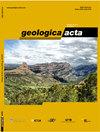Distribution and provenance of heavy minerals from recent sediments of Green Lake, North Brazil, revisited
IF 2
4区 地球科学
Q2 GEOLOGY
引用次数: 0
Abstract
Geostatistical and multivariate statistical analyses were applied to heavy mineral data from an Amazonian fluvial-lake system near the Tapajós River mouth to investigate the spatial distribution and source-area of sediments. Twenty-one points were investigated, and the physical characteristics of the Green Lake deepest point were determined. Sand accumulates in the lake margins and mud quantity increases towards the lake center. Heavy mineral assemblage is composed of zircon, tourmaline, kyanite, rutile, staurolite, anatase, sillimanite, garnet, and spinel. Tourmaline, staurolite, and spinel are more abundant in the southeast area of the lake, while kyanite is dominant in the north area and zircon is in the whole lake except in its southeast area. Zircon - tourmaline and zircon - staurolite pairs are negatively correlated (r= -0.947 and -0.775, respectively), while tourmaline - staurolite and sillimanite - anatase pairs have a positive correlation (r= 0.628 and 0.675, respectively) which indicate different source rock types. Geostatistical analysis grouped the heavy minerals in three grups: Group 1 (tourmaline – staurolite – spinel - kyanite) and Group 2 (garnet – rutile – sillimanite - anatase) related to metamorphic source rocks ranging from medium to high grade, and Group 3 (zircon) related to acid igneous source rocks. The heavy mineral assemblage of Green Lake is analogous to the assemblage of the Alter do Chão Formation, indicating that this formation is the source of sediments of Green Lake.重访巴西北部绿湖近期沉积物中重矿物的分布和来源
将地统计学和多元统计分析应用于Tapajós河口附近亚马逊河湖系统的重矿物数据,以调查沉积物的空间分布和来源区域。对21个点进行了调查,确定了绿湖最深点的物理特征。沙在湖边缘堆积,泥量向湖中心增加。重矿物组合由锆石、电气石、蓝晶石、金红石、十字石、锐钛矿、硅线石、石榴石和尖晶石组成。电气石、十字石和尖晶石在湖的东南部地区更为丰富,蓝晶石在北部地区占主导地位,锆石除东南部地区外在整个湖中都有分布。锆石-电气石和锆石-十字石对呈负相关(r=-0.947和-0.775),电气石-十字石和硅线石-锐钛矿对呈正相关(r=0.628和0.675),表明不同的烃源岩类型。地质统计分析将重矿物分为三组:第1组(电气石-十字石-尖晶石-蓝晶石)和第2组(石榴石-金红石-硅线石-锐钛矿)与中高级变质烃源岩有关,第3组(锆石)与酸性火成烃源岩关系。绿湖的重矿物组合与Alter do Chão组的组合相似,表明该组是绿湖沉积物的来源。
本文章由计算机程序翻译,如有差异,请以英文原文为准。
求助全文
约1分钟内获得全文
求助全文
来源期刊

Geologica Acta
地学-地质学
CiteScore
2.50
自引率
6.70%
发文量
13
审稿时长
>12 weeks
期刊介绍:
- Relevant conceptual developments in any area of the Earth Sciences.
- Studies presenting regional synthesis.
- Thematic issues or monographic volumes presenting the results from one or more research groups.
- Short papers reflecting interesting results or works in progress.
- Contributions and results from Research Projects, Workshops, Symposiums, Congresses and any relevant scientific activity related to Earth Sciences.
- Geologica Acta aims to stimulate rapid diffusion of results and efficient exchange of ideas between the widespread communities of Earth Science researchers (with special emphasis on Latinamerica, the Caribbean, Europe, the Mediterranean
 求助内容:
求助内容: 应助结果提醒方式:
应助结果提醒方式:


